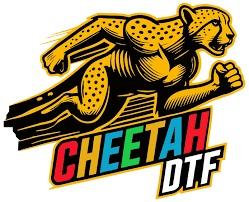Everything You Need to Know About DTF Transfer Sheets

Introduction
Direct-to-Film (DTF) transfer sheets have revolutionized the custom printing industry, providing a versatile and cost-effective solution for apparel decoration. Whether you're an entrepreneur looking to expand your business or a hobbyist interested in personalizing garments, understanding DTF transfer sheets can help you make the most of this technology.
What Are DTF Transfer Sheets?
DTF transfer sheets are specialized films used in the Direct-to-Film printing process. Unlike traditional heat transfer vinyl (HTV) or screen printing, DTF printing allows designs to be printed onto a transparent film, which is later transferred onto fabric using heat and pressure.
Key Features of DTF Transfer Sheets:
-
Vibrant Colors: They enable high-resolution prints with bright and durable colors.
-
Versatility: Can be applied to a wide range of fabrics, including cotton, polyester, blends, and even leather.
-
Soft Feel: Unlike some other transfer methods, DTF results in a smooth and flexible print.
-
Durability: The designs are resistant to washing, cracking, and fading.
-
No Weeding Required: Unlike vinyl transfers, DTF sheets eliminate the need for intricate weeding.
How Do DTF Transfer Sheets Work?
DTF transfer sheets work through a multi-step process that involves printing, powder application, curing, and heat pressing. Below is a step-by-step guide:
-
Printing the Design: A specialized DTF printer prints the design onto the transfer sheet using a water-based pigment ink.
-
Applying Adhesive Powder: A special adhesive powder is applied to the printed design while it is still wet.
-
Curing the Transfer Sheet: The sheet is heated to cure the adhesive, making it ready for transfer.
-
Heat Pressing: The design is transferred onto the fabric using a heat press machine at a specific temperature and pressure.
-
Peeling the Film: Once the design has adhered to the fabric, the transfer film is peeled away, leaving a high-quality print.
Advantages of Using DTF Transfer Sheets
DTF transfer sheets offer several benefits that make them superior to other transfer methods:
-
No Fabric Limitations: Unlike sublimation printing, which requires polyester fabrics, DTF transfer sheets work on all types of materials.
-
Lower Production Costs: Compared to screen printing, which requires costly setups, DTF is more affordable, especially for small businesses.
-
Eco-Friendly: Uses water-based inks, making it a more sustainable printing solution.
-
Intricate Designs: Can handle fine details and complex gradients that may not be possible with other transfer techniques.
-
Time-Saving: The process is faster compared to traditional methods like screen printing.
How to Use DTF Transfer Sheets for Best Results
To ensure the best quality prints using DTF transfer sheets, follow these best practices:
-
Use High-Quality DTF Printers and Ink: The quality of the printer and ink impacts the final print.
-
Proper Powder Application: Ensure even coating of the adhesive powder for a smooth transfer.
-
Correct Heat Press Settings: Different fabrics require different temperature and pressure settings.
-
Store Transfer Sheets Properly: Keep them in a cool, dry place to prevent deterioration.
-
Wash Garments Correctly: To maintain longevity, wash printed garments inside out with mild detergents.
Common Applications of DTF Transfer Sheets
DTF transfer sheets are used in various industries for customization and branding. Some common applications include:
-
Custom T-Shirts and Hoodies: Ideal for personal and commercial apparel printing.
-
Sportswear and Jerseys: Durable and stretchable prints for athletic wear.
-
Canvas Bags and Accessories: Perfect for branding tote bags and other promotional materials.
-
Home Textiles: Used for printing designs on pillowcases, cushion covers, and curtains.
-
Workwear and Uniforms: Suitable for branding uniforms with logos and company names.
DTF Transfer Sheets vs. Other Printing Methods
While there are several printing methods available, DTF transfer sheets stand out for their ease of use and versatility. Here's how they compare to other techniques:
| Feature | DTF Transfer Sheets | Sublimation | Heat Transfer Vinyl (HTV) | Screen Printing |
|---|---|---|---|---|
| Fabric Compatibility | All Fabrics | Only Polyester | Limited | Cotton & Blends |
| Durability | High | High | Medium | High |
| Color Vibrancy | Excellent | Excellent | Good | Excellent |
| Cost-Effective for Small Runs | Yes | No | Yes | No |
| Ease of Use | Easy | Moderate | Moderate | Difficult |
Where to Buy DTF Transfer Sheets
DTF transfer sheets are widely available through online marketplaces and specialty printing suppliers. When purchasing, consider the following:
-
Quality of Sheets: Ensure they are compatible with your printer and ink.
-
Size Options: Choose sizes that match your project needs.
-
Bulk Discounts: Buying in bulk can save costs if you have high production demands.
-
Customer Reviews: Check for feedback on durability and ease of use.
Conclusion
DTF transfer sheets have opened up new possibilities in the custom printing industry. With their ability to print on various fabrics, produce vibrant designs, and provide long-lasting results, they are a game-changer for both businesses and individual creators. Whether you're starting a new printing business or looking to improve your current setup, investing in DTF transfer sheets can be a smart move.
By understanding their applications, benefits, and best practices, you can maximize the potential of DTF transfer sheets and create stunning, high-quality prints every time.





